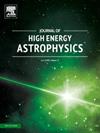Gamma-ray bursts calibrated from the observational H(z) data in artificial neural network framework
IF 10.5
4区 物理与天体物理
Q1 ASTRONOMY & ASTROPHYSICS
引用次数: 0
Abstract
In this paper, we calibrate the luminosity relation of gamma-ray bursts (GRBs) from an Artificial Neural Network (ANN) framework for reconstructing the Hubble parameter from the latest observational Hubble data (OHD) obtained with the cosmic chronometers method in a cosmology-independent way. We consider the physical relationships between the data to introduce the covariance matrix and KL divergence of the data into the loss function and calibrate the Amati relation (–) by selecting the optimal ANN model with the A219 sample and the J220 sample at low redshift. Combining the Pantheon+ type Ia supernovae (SNe Ia) sample and Baryon acoustic oscillations (BAOs) from Dark Energy Spectroscopy Instrument (DESI) with GRBs at high redshift in the Hubble diagram by Markov Chain Monte Carlo numerical method, we find that the ΛCDM model is preferred over the wCDM and CPL models with joint constraints by the Akaike Information Criterion and Bayesian Information Criterion.
基于人工神经网络框架的观测H(z)数据校准的伽马射线暴
本文采用人工神经网络(ANN)框架,对伽玛射线暴(GRBs)的光度关系进行了校准,该框架用于重建哈勃参数H(z),该参数H(z)是用宇宙天文钟方法获得的最新哈勃观测数据(OHD),与宇宙学无关。我们考虑数据之间的物理关系,将数据的协方差矩阵和KL散度引入到损失函数中,并通过选择A219样本和J220样本在低红移时的最优ANN模型来校准Amati关系(Ep-Eiso)。利用马尔可夫链蒙特卡罗数值方法,将Pantheon+ Ia型超新星(SNe Ia)样本和暗能量谱仪(DESI)的重子声学振荡(BAOs)与哈勃图中高红移的GRBs结合起来,发现ΛCDM模型优于Akaike信息准则和Bayesian信息准则联合约束的wCDM和CPL模型。
本文章由计算机程序翻译,如有差异,请以英文原文为准。
求助全文
约1分钟内获得全文
求助全文
来源期刊

Journal of High Energy Astrophysics
Earth and Planetary Sciences-Space and Planetary Science
CiteScore
9.70
自引率
5.30%
发文量
38
审稿时长
65 days
期刊介绍:
The journal welcomes manuscripts on theoretical models, simulations, and observations of highly energetic astrophysical objects both in our Galaxy and beyond. Among those, black holes at all scales, neutron stars, pulsars and their nebula, binaries, novae and supernovae, their remnants, active galaxies, and clusters are just a few examples. The journal will consider research across the whole electromagnetic spectrum, as well as research using various messengers, such as gravitational waves or neutrinos. Effects of high-energy phenomena on cosmology and star-formation, results from dedicated surveys expanding the knowledge of extreme environments, and astrophysical implications of dark matter are also welcomed topics.
 求助内容:
求助内容: 应助结果提醒方式:
应助结果提醒方式:


